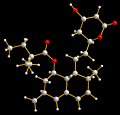Although H5N1, the avian influenza virus, darling of a scare-mongering media is lethal. No doubt about it. It’s just that at this point in human history, this virus is not in a human transmissable form, thankfully.
Now, a new study of patients who became infected with H5N1 in Vietnam has revealed clues as to why the virus is so lethal.
Menno de Jong and colleagues compared viral levels and effects on the immune system in one group of patients infected with H5N1 and another group infected with two types of human flu virus. The patients with H5N1 infection had much greater viral load in the throat than the patients infected with the human virus; markers of viral load were highest in the H5N1 patients who died. Virus could also frequently be detected in the blood of H5N1 patients but only in those who died.
The authors found that H5N1 virus at high levels triggers the release of inflammatory cytokines and that levels of these compounds is associated with a higher viral load. Fatal H5N1 infection was also associated with a loss of white blood cells in the peripheral blood.
The authors posit that H5N1 replicates much faster than human flu virus and that the high levels of the virus trigger an overwhelming inflammatory response that contributes to lung dysfunction and eventually death. They report their results in Nature Medicine today.
An important point that should be made is that the lower virulence of human flu is the mechanism by which this virus has remained endemic in humans and infects millions year in year out. If it were highly virulent, like H5N1, it would kill too many hosts to be persistent year in year out. As a dead host cannot infect another in the same way as a living one in direct contact. It is not necessarily true that H5N1 will mutate immediately into such a persistent viral sub-strain. The likelihood is that it will mutate into a fast-infecting form initially, but such a form will remove hosts from the ecosystem too quickly to remain endemic in the way that common human flu is. Viz, we don’t see the 1918 flu today because it died out.
 There has been a lot of discussion over the summer as to whether we should all be getting a bit more sun to boost cancer-fighting vitamin D levels. That argument coupled with revelations that suntan creams might themselves boost the risk of skin cancer all fly in the face of the contrary view that we should be staying in the shade.
There has been a lot of discussion over the summer as to whether we should all be getting a bit more sun to boost cancer-fighting vitamin D levels. That argument coupled with revelations that suntan creams might themselves boost the risk of skin cancer all fly in the face of the contrary view that we should be staying in the shade.
 Cellulite is of growing concern to a huge number of women and many consider different ways of reducing it including bariatric surgery or a tummy tuck liposuction procedure, diets and other methods, while others really couldn’t care less about the superficial dimpling of their subcutaneous fat. Moreover, it provides yet another example of the medicalisation of a perfectly harmless “condition” as exemplified by the description of “sufferers” as patients.
Cellulite is of growing concern to a huge number of women and many consider different ways of reducing it including bariatric surgery or a tummy tuck liposuction procedure, diets and other methods, while others really couldn’t care less about the superficial dimpling of their subcutaneous fat. Moreover, it provides yet another example of the medicalisation of a perfectly harmless “condition” as exemplified by the description of “sufferers” as patients.